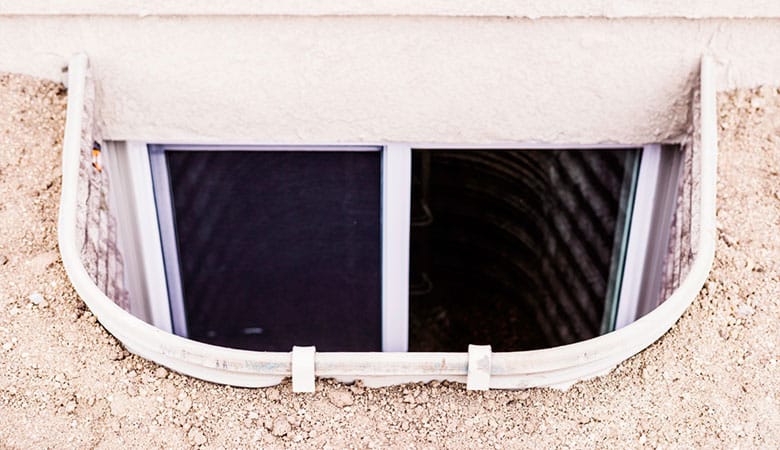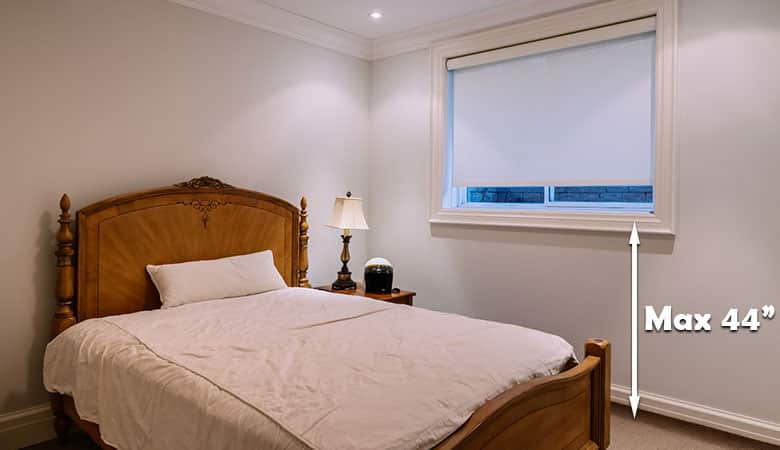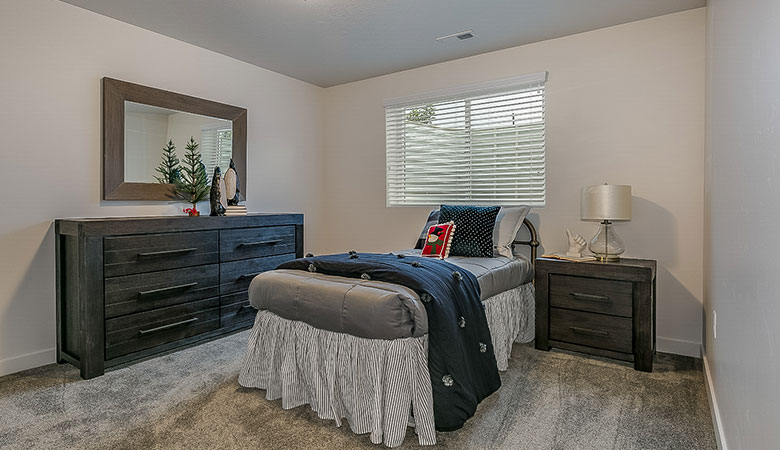Have you ever thought of converting that unused basement of yours into an extra bedroom?
Depending on your basement and your lifestyle, this could be an excellent idea to increase the value of your house or to earn some extra income by renting it out.
Read on to find out what legal hoops you need to jump through in order to convert your basement into a bedroom.
The deciding factor that qualifies your basement as a bedroom is whether or not there is a window. If you are able to fit a window, that meets certain size and height restrictions, into your basement, then you can legally classify your basement as a bedroom. This has to do with having a clear escape route.
Technically Speaking You Need a Window, With The Correct Measurements
From a legal point of view, your basement can only be classified as a bedroom if there is a window in the room. This window has to meet certain size and height requirements that change from country to country. In the US this falls under the International Code Council (ICC) standards.
The thinking behind this is that a window can be used as an emergency escape route in the event of an unexpected emergency. While it’s not so nice to think about the unlikely event of an emergency, these things need to be considered so that we can be prepared.
A bedroom that only has one exit is an accident waiting to happen. Especially if that exit is at the top of a steep staircase. If something were to happen, a fire for example. And that exit is blocked or the staircase collapses. There is very little chance that the people in that basement will be able to escape.
We don’t need to go into any more detail there as I’m sure you can imagine the outcome without me having to explain it.
That’s why, by law, there has to be a window in any basement that has been converted into a bedroom. And not just any window either. The window has to be big enough and situated low enough in the wall to act as an emergency escape in the event of an emergency.
The size and height of this window changes depending on the building code used in your area and in your country. So it is advised to check your local building codes to make sure you get it right.
Window Size and Availability Requirements

In the US, according to the ICC, you need to have a window that opens to the outside and that can be opened easily without keys or tools. Furthermore, the window must follow the code requirements for the width and heigh of basement windows. The requirements are:
- A window with a minimum opening width of 20 inches.
- A window with a minimum opening height of 24 inches.
- A window with a minimum net clear opening — the actual opening through which a person must crawl — of 5.7 square feet.
- A sill height below 44 inches above the floor.
- A window well floor space of 9 square feet with minimum dimensions of 36 inches wide and long.
- A permanent ladder or steps if the window well depth is more than 44 inches.
An emergency escape is not the only thing that these size requirements are concerned about. Another aspect that window size has an effect on is light and ventilation. In building codes, there are certain targets you need to hit when it comes to natural light and natural ventilation in bedrooms.
The minimum size of basement bedroom windows will take this into consideration and will make sure that your bedroom is both light and airy enough to meet these requirements.
Clarifying The ICC Requirements
For better clarification, here’s a more in depth explanation of the list above.
First off, let’s start with windows as an emergency escape. The part of the window that can be opened must be at least 5.7 square feet. This only applies if the sill of the window is above the ground level outside. If not, the overall dimension of the window must be at least 9 feet.
Window openings need to be at least 24 inches wide and at least 20 inches high. If the windowsill of a bedroom basement is lower than the ground level outside, there needs to be a window well on the outside that meets another set of minimum requirements.
Next comes the height of the window sill. Bedroom window sills cannot be any higher than 44 inches above the floor of the bedroom. In older homes, the window sills are often a lot lower than this.

There is an exception for basement bedrooms though. The window sill can be higher than 44 inches if there is a permanent ladder or stairway leading up to the window. Remember, you need to be able to escape through this window in the unlikely event of an emergency.
What About Lightning And Ventilation?
First, let’s talk about natural light. Everyone seems to want natural light in all rooms of their house. While it’s lovely to live in a house that is always bathed in natural light, there is in fact a legal requirement regarding how much light enters your home.
If your municipality follows the Uniform Building Code (UBC) the area of the window must be no less than one-tenth of the room’s floor area.
If you have to follow the International Residential Code (IRC), this requirement drops to only 8 percent of the floor area of the room.
In terms of ventilation, there are different requirements for the size of the window. The UBC requires that the area of the window is no less than one-twentieth of the area of the room. While the IRC requires only 4 percent of the area of the room to be the window.
The above information covers the legal requirements of a bedroom in a basement. But there are plenty of other things that go into deciding if your basement is a good place to put a bedroom. The rest of this post will look at a few things that you should consider when deciding if your basement is a good fit to be converted into a bedroom.
Beyond The Law: Is Your Basement Actually a Good Living Area?

Adding an additional bedroom to your basement can add value to your home if it’s done right. If you don’t consider some of these important points though, it might end up being a disaster.
Is Your Basement Insulated?
When you go down to your basement, how does it feel? Colder than the rest of the house? Most houses are built with uninsulated basements. Which is not a problem if you’re using your basement just for storage. If you want to convert your basement into a bedroom, though, this might be a problem.
You’ll want to insulate against colder temperatures and noise. There are a variety of insulation options available. So do your research around which insulation fits your budget and your needs.
Is Your Basement Damp/Moist Free?
Another thing to consider is moisture. Is damp an issue in your basement? Is there proper drainage around the outside? A flooded basement can be a disaster in the best of times. This problem will be a lot worse if there is a bedroom down there.
A simple moisture barrier can take care of mild damp issues. This usually takes the form of a thin sheet of plastic and it can be installed at the same time as the insulation we discussed above.
If your basement is prone to flooding, you have a bigger problem on your hands and you should consult with your local building professional.
Is Your Basement Radon Free?
Radon is another thing you need to think about when it comes to converting your basement into a bedroom. Radon is a type of gas that comes from the ground in certain areas. This gas does not have a smell and radon poisoning can be fatal.
Luckily, radon test kits are readily available and inexpensive. If radon is present, there are certain things you can do to eliminate the threat. Your building professional should be able to advise you on the best ways to prevent any disasters featuring radon.
Is Your Basement Pest/Rot Free?
Make sure you thoroughly inspect the basement for any signs of pests or rot. This is an issue best tackled before you start any significant renovations as pest issues could require fumigation and rot issues could require partial demolition to get to the source of the problem.
Is There Easy Access to Your Basement Bedroom?
Now think about the access to the basement. Is the staircase steep and narrow? Remember that you are going to have to put large furniture like beds and wardrobes in your new basement bedroom. So enough room to move these furniture pieces in and out of the space is essential.
If you’re lucky, you might have the chance to create a ‘walkout’ from your basement. This is basically a separate entrance for your basement. This will give whoever is using the basement bedroom a feeling of privacy that would be perfect for a moody teenager or for tenants if you decide to rent out your extra bedroom.
To Conclude
In the end, the biggest things you have to keep in mind when converting your basement into a bedroom concerns safety. There has to be an easy and obvious escape route as well as plenty of natural light and ventilation.
Give your basement a thorough inspection before you move ahead with the renovation to make sure that you don’t encounter any nasty surprises later on once the renovation is complete or nearly complete.
If done right, the extra bedroom could increase the value of your home as well as being an extra sleeping space for all those guests over the holidays.
